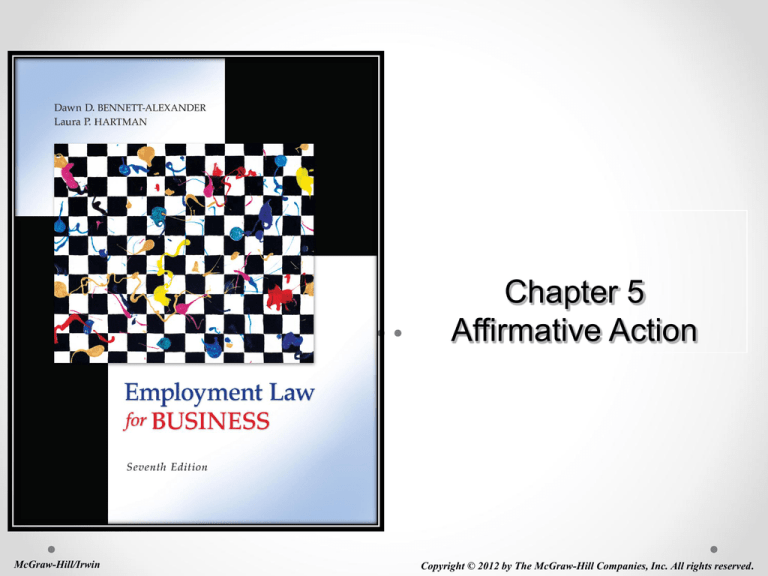
Chapter 5
Affirmative Action
McGraw-Hill/Irwin
Copyright © 2012 by The McGraw-Hill Companies, Inc. All rights reserved.
Learning Objectives
Discuss what affirmative action is and why it was
created
Provide the results of several studies indicating
why there continues to be a need to take more
than a passive approach to equal employment
opportunity
Name and explain the three types of affirmative
action
5-2
Learning Objectives
Explain when affirmative action plans are
required and how they are created
List the basic safeguards put in place in
affirmative action plans to minimize harm to
others
Define “reverse discrimination” and tell how it
relates to affirmative action
5-3
Learning Objectives
Explain the arguments of those opposed to
affirmative action and those who support it
Explain the concept of valuing
diversity/inclusion/multiculturalism/why it is
needed, and give examples of ways to do it
5-4
Affirmative Action
Affirmative action: Intentional inclusion of
women and minorities in the workplace
Based on a finding of their previous exclusion
5-5
What Is Affirmative Action?
Steps to hire qualified women and minorities or
other statutorily mandated groups who are
underrepresented in the workplace
Actions an employer can take
Expand outreach to new groups
Recruitment of previously neglected groups
Mentoring, management training, and development
Hiring and training groups that tended to be left out of
the employment process
5-6
Has Affirmative Action Outlived It’s
Usefulness?
Bills and acts that led to the rise of the American
middle-class left African-Americans well out of
the loop
Research shows that women and minorities still
lag behind in terms of employment, pay and
promotions
5-7
Has Affirmative Action Outlived It’s
Usefulness?
Title VII passive approach
Affirmative action active approach
Active approach required to remove a system that
has been in place for 346 years
5-8
Employment Research Findings
Research shows that people who hire tend to
notice value more quickly in someone who looks
like them
In the suburbs, equally qualified blacks are hired
about 40 percent less than whites because of
negative assumptions
Almost 90 percent of jobs are filled through
word-of-mouth – fewer minorities and women
being able to take advantage of those networks
5-9
Employment Research Findings
In one experiment, retailers consistently chose
slightly less qualified white women over more
qualified black women in entry-level positions
When black and white discrimination testers who
are similar in qualifications, dress, and so on
applied for jobs, whites were 45 percent more
likely to receive job offers and 22 percent more
likely to receive interviews
5-10
How Do Affirmative Action Obligations
Arise?
There are three ways in which affirmative action
obligations arise
Through Executive Order 11246
Judicially as a remedy for a finding of discrimination
under Title VII
Voluntary affirmative action established by an
employer
5-11
Affirmative Action Under Executive
Order 11246
Affirmative action actually stems from a
requirement imposed by Executive Order 11246
and its amendments
Present version signed into law
September 24, 1965
Executive Order 8802
Forerunner to E.O. 11246
Signed on June 25, 1941
Applied only to defense contracts
5-12
E.O. 11246 Provisions
Prohibits discrimination in employment –
requires contractors to remedy inadequate
representation of women and minorities in their
workplace
Enforced by the Office of Federal Contract
Compliance Programs (OFCCP)
Only applies to federal government contracts
Increases compliance requirements based on
the amount of the contract
5-13
Affirmative Action Plans
Affirmative action plan: Must be developed
according to the rules set forth in the Code of
Federal Regulations part 60-2
Underrepresentation / Underutilization:
Significantly fewer minorities or woman in the
workplace than relevant statistics indicate are
available
Or their qualification indicate they should be working
at better jobs
5-14
Affirmative Action Plans
Organizational profile: Staffing patterns
showing organizational units
Their relationship to each other; and gender, race
Ethnic composition
Job group analysis: Combines job titles with
similar content, wage rates, and opportunities
5-15
Affirmative Action Plans
Availability: Minorities and women in a
geographic area who are qualified for a
particular position
Factors used to determine availability:
The percentage of minorities or women with requisite
skills in the reasonable recruitment area
The percentage of minorities or women among those
promotable, transferable, and trainable within the
contractor’s organization
5-16
Affirmative Action Plans
Placement goal: Percentage of women and/or
minorities to be hired to correct
underrepresentation
Based on availability in the geographic area
Quotas are expressly forbidden
5-17
Affirmative Action Plans
Corporate management compliance
evaluations: Evaluations of mid and senior-level
employee advancement for artificial barriers to
advancement of women and minorities
OFCCP Equal Opportunity Survey every year
5-18
Affirmative Actions Used by Some
Employers
Advertising for applicants in nontraditional
sources
One-for-one hiring, training, or promotion
programs
Preferential layoff provisions
5-19
Affirmative Actions Used by Some
Employers
Extra consideration
Lower standards
Added points
Minority or female “positions”
5-20
Penalties for Noncompliance
The Secretary of Labor or the appropriate
contracting agency can impose a number of
penalties on the employer
The Secretary of Labor must make reasonable
efforts to secure compliance by conference,
conciliation, mediation, and persuasion before
requesting the U.S. Attorney General to act or
before canceling or surrendering a contract
5-21
Penalties for Noncompliance
What is important to OFCCP?
The nature and extent of the contractor’s good-faith
affirmative action activities
The appropriateness of those activities to the
problems the contractor has identified in the
workplace
5-22
Judicial Affirmative Action
Judicial affirmative action: Affirmative action
ordered by a court, rather than arising from
Executive Order 11246
There are no specific requirements as to what
form an affirmative action plan must take
Regents of the University of California v. Bakke
Local 28, Sheet Metal Workers v. E.E.O.C.
5-23
Voluntary Affirmative Action
The employer decides to institute an affirmative
action plan regardless of the Executive Order,
and despite no Title VII cases being brought
Proactive measure to avoid discrimination claims
Strict guidelines must be followed
Steelworkers of America, AFL-CIO v. Weber
5-24
Reverse Discrimination
Reverse discrimination: Claim brought by
majority member
who feels adversely affected by the use of an
employer’s affirmative action plan
mistakenly considered as the flip side of affirmative
action
Reverse discrimination accounts for only about 3
percent of the charges filed with EEOC
5-25
Reverse Discrimination
Glass Ceiling Commission Report
White men are only 43 percent of the Fortune 2000
workforce but hold 95 percent of the senior
management jobs
Women and minorities are underrepresented in most
professions
5-26
Opposing Views of Affirmative Action
Con – Clarence Pendleton, Chair of the U.S.
Commission on Civil Rights
“New racism”
Preferential treatment – “neo-slavery”
Pro – Richard Womack, Director, Office of Civil
Rights for the AFL-CIO
White males have had the advantage of preference in
the workplace for years
5-27
Affirmative Action and Veterans
Jobs for Veterans Act of 2002.
Contractors must take affirmative action to hire
and promote qualified veterans.
Under the law, generally, “qualified targeted
veterans are entitled to priority for referral to
federal contractor job openings”
5-28
Valuing Diversity/Multiculturalism
Hudson Institute’s “Workforce 2000” study for
the U.S. Department of Labor in 1987
Valuing diversity: Learning to accept and
appreciate those who are different from the
majority and value their contributions to the
workplace
5-29
Management Tips
Ensure that the hiring, promotion, training, and
other such processes are open, fair, and
available to all employees on an equal basis
Work with the union and other employee groups
to try to ensure fairness of adopted plans
Get early approval from the constituencies
affected to ward off potential litigation
5-30
Management Tips
Make sure voluntary affirmative action plans
meet established judicial requirements
Provide training about the plan so that all
employees understand its purpose and intent.
Implement periodic diversity and related training.
5-31











